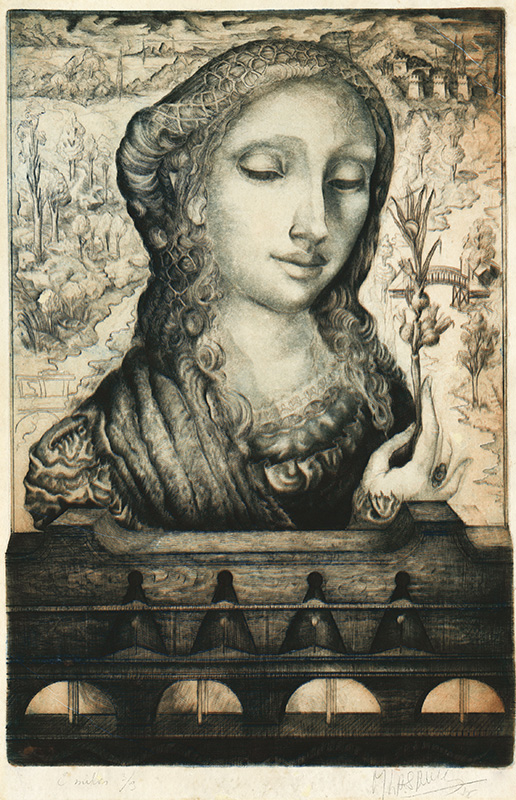Emilia is a color drypoint from 1940 by Argentine-born, American printmaker Mauricio Lasansky. This impression is pencil signed, dated, editioned 3/3, and inscribed in pencil by the artist Emilia. Emilia was printed by the artist in sienna, black, and cobalt blue inks from the same zinc plate. A variant of this image is illustrated on page 73 in Lasansky: Printmaker (University of Iowa Press) and identified as Estudio para un Retrato, a drypoint printed in two colors in an edition of ten. Estudio para un Retrato is the second state of the plate as it lacks the architectural arches along the portion of the image. The references are Lasansky 43 and Zigrosser 43. In this raisonné, Emilia is listed on page 74 (Lasansky 45, Zigrosser 46) but there were no impressions to measure or to photograph. It is possible that this impression is Lasansky 45.
This is a rare Surreal portrait of Lasansky’s wife Emilia, whom he had married in 1937. The Bottocelli-like figure is portrayed behind a type of altar. She holds a plant while an intricate landscape stretches to infinity contrasting the delicate, dream-like state of the subject. Emilia was created in Argentina in 1940, three years before Lasansky left for New York to work at Atelier 17.
In Lasansky: Printmaker, Alan Fern commented about these early drypoints: The drypoints...are lyrical and imaginative, relying on surrealist juxtapositions of interior and exterior space, objects in different scale, and interpenetrations of one form by another. These early works are consciously poetic; many of Lasansky's friends and intellectual heroes were poets and writers, who used language in the Spanish tradition with a rich employment of metaphors, strange juxtapositions of objects and ideas, and the frequent expression of states of mind in similes - equivalents for feelings being made vivid by references to objects.
Maurico Lasansky, was born in Buenos Aires, Argentina in 1914. He attended the Superior School of Fine Arts in 1933 and his first solo exhibition was held in 1935 at Fort General Roca. In 1936, Lasansky directed the Free Fine Arts School in Villa Maria, Cordoba. Francis Henry Taylor, director of the Metropolitan Museum of Art, met Lasansky in 1941 and arranged for him to travel to New York on a Guggenheim Fellowship. In New York, he worked at Atelier 17 expanding his printmaking prowess.
Hired by the University of Iowa in 1946, Lasansky renovated the university’s printmaking department, making Iowa a germinal school for printmaking, and he was made a full professor of art in 1948. In 1960, the Ford Foundation sponsored his retrospective and, in 1975, the University of Iowa honored him with a retrospective accompanied by a catalogue raisonné by John Thein and Phillip Lasansky. Alan Fern wrote: “[His] subject has remained the human being—his condition, his relationships, his society—but the great change has been in Lasansky’s command of the visual arts, and in his relationship to the work of other artists.”
Lasansky received five Guggenheim Fellowships, six honorary doctoral degrees and many special honors. His work is represented in the collections of numerous universities across the United States as well as the Museo de Arte Moderno, Barcelona; the Brooklyn Museum, New York; the Cedar Rapid Museum of Art, Iowa; the Art Institute of Chicago, Illinois; the Uffizi Gallery, Florence; the Museo de Arte Contemporaneo, Madrid; the Museum of Modern Art and the Whitney Museum of American Art, New York; the Pennsylvania Academy of the Fine Arts, Philadelphia; the Portland Art Museum, Oregon; the Seattle Art Museum, Washington; the Library of Congress, the National Gallery of Art, and the Smithsonian American Art Museum, Washington, D.C.
Maurico Lasansky died on 2 April 2012 in Iowa City.



